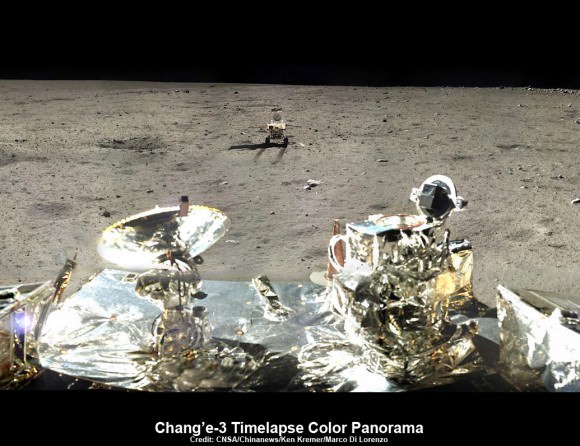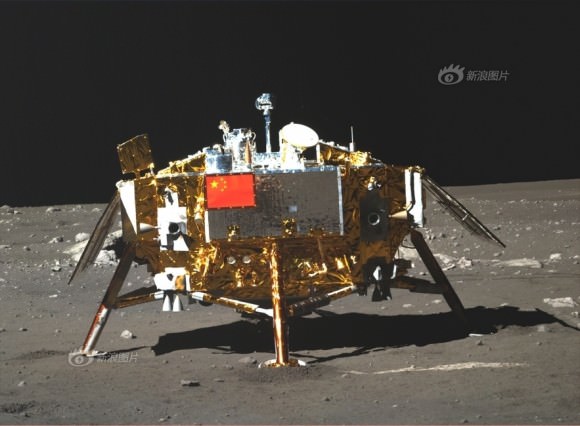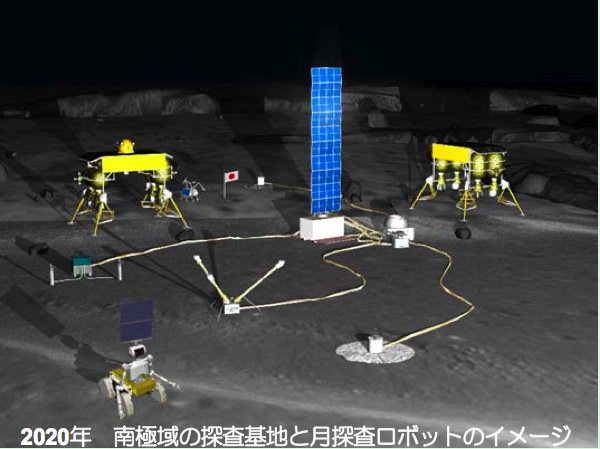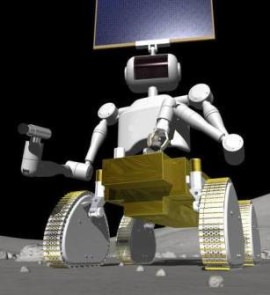This time-lapse color panorama from China’s Chang’e-3 lander shows the Yutu rover at two different positions during its trek over the Moon’s surface at its landing site from Dec. 15-18, 2013. This view was taken from a 360-degree panorama – see below.
Credit: CNSA/Chinanews/Ken Kremer/Marco Di Lorenzo
Story updated
This mosaic was selected as Astronomy Picture of the Day (APOD) on Feb. 3, 2014
http://apod.nasa.gov/apod/ap140203.html[/caption]
A new time-lapse photomosaic shows China’s Yutu rover dramatically trundling across the Moon’s stark gray terrain in the first week after she rolled all six wheels onto the desolate lunar plains.
Our complete time-lapse mosaic (see below) shows Yutu at three different positions trekking around the landing site, and gives a real sense of how it is maneuvering around – on the 1st Lunar Day.
The 360-degree panoramic mosaic was created from images captured by the color camera aboard China’s Chang’e-3 lander, the country’s first spacecraft to successfully soft land on the Moon.
The time-lapse mosaic was stitched together by the imaging team of scientists Ken Kremer and Marco Di Lorenzo using images just released on a Chinese language website.
We integrated the wide screen panorama with additional images of Yutu taken by the lander as she roved around the right side of the mothership during her 1st Lunar Day – to create the new time-lapse panorama.
To me the moonscape is rather reminiscent of the scenery from NASA’s manned Apollo lunar landing missions which took place over 4 decades ago – from 1969 to 1972.

Our time-lapse Yutu mosaic was initially featured at NBC News by Alan Boyle – here.
Here’s the original 360 degree panorama:

The first portrait of Yutu was taken shortly after it first drove off the 1200 kg Chang’e-3 lander on Dec. 15. The last Yutu position shows her heading off to the south and departing the landing site forever.
She’s not ever coming back to see the stationary lander again, according to China’s Chang’e-3 mission team.
Yutu, which translates as ‘Jade Rabbit’, is on her own from now on.

Chang’e-3 safely touched down on the Moon at Mare Imbrium near the Bay of Rainbows on Dec. 14, 2013.
Seven hours later, the piggybacked 140 kg Yutu robot drove off a pair of ramps, onto the Moon and into the history books.
Here is the initial black and white panoramic version from the Chang’e-3 navigation camera – which we assembled from screenshots taken as it was twirling about in a CCTV news video report.

The Chang’e-3 mothership and Yutu rover are now working during their 2nd Lunar Day, having survived the harsh extremes of their 1st Lunar Night when temperatures plummeted to below minus 180 degrees Celsius, or minus 292 degrees Fahrenheit.
They have resumed full operation and are conducting research investigations. Each is equipped with four science instruments.
All the equipment is functioning well except alas for the color camera used to snap the images for the photomosaics herein.

China’s official Xinhua new agency reports that the instruments aboard the lander and rover have each collected a large amount of data about the Moon, Earth and celestial objects.
Scientists have created a star atlas around the constellation Draco and used the ground penetrating radar to survey the moon’s subsurface and soil structure to depths of 10 to 140 meters.
Meanwhile as China’s Yutu rover trundles across pitted moonscapes, NASA’s Opportunity rover is in the midst of Martian mountaineering at the start of Decade 2 on the Red Planet and younger sister Curiosity is speeding towards the sedimentary layers of Mount Sharp.
Stay tuned here for Ken’s continuing Chang’e-3, Orbital Sciences, SpaceX, commercial space, LADEE, Mars and more news.





